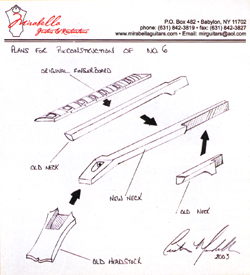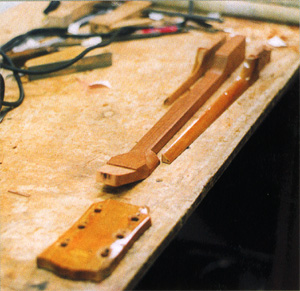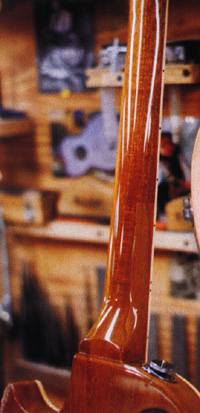Article on the smash and subsequent repair of the No. 6 Les Paul Deluxe Gold Top in 1975, from 20th Century Guitar
Article on the smash and subsequent repair of the No. 6 Les Paul Deluxe Gold Top in 1975
From 20th Century Guitar, September 2004
The resurrection of Pete Townshend’s No.6
By Lawrence Acunto
In the mid-seventies, Pete Townsend [sic] was known to be seen on stage with a number of Les Paul Deluxe Model guitars, some sunburst, some gold, some with an added middle pickup, but all with a large number placed on the face of the instrument, perhaps making it easier to quickly identify each as he changed guitars during the show. Pictured on these pages is just one such guitar, Number 6, with an interesting, if not somewhat disturbing, history.
The origin of the guitar, as well as how and why it became Number 6, is unknown. In fact, little is known about the instrument until Tuesday, December 23, 1975, when two unsuspecting Who fans, awaiting a glimpse of their favorite guitarist outside the stage door of the famous Hammersmith Odeon in London, suddenly found themselves watching the guitar come hurtling towards them out of a second story window. As one of the two instinctively attempted to catch it, breaking two fingers in the process, the guitar hit the ground neck first, snapping off the headstock at the nut and causing other equally painful damage to the neck.
As the guitar was broken cleanly in two, it was decided that the injured party would get the body and his friend, the headstock. Their plans, though were quickly put on hold as the air were set upon by other fans who, too, wanted a piece of the Gold Top. Before the scene became and all-out free-for-all, none other than Ringo Starr appeared from the stage door, saw what was happening and said, “Leave them alone, it’s their guitar.” Ringo apparently, charmingly defused the situation (who’s going to argue with a Beatle?) And the two friends rode home on the train with their souvenirs.
The current owner of the guitar knew of this story and even the whereabouts of the headstock. He had seen the information and a picture posted on a Who-related website. Unfortunately, the two friends under that window in 1975 had lost contact and hadn’t spoken with one another for over twenty years. The current owner attempted to hunt down the pieces but eventually reached a dead end. Finally, in 2002, through a U.K. contact, he was offered the piece of the guitar as a “smashed Townshend guitar.” The headstock and body were once again reunited, although not quite in the same fashion as when they originally left the factory.
With the pieces back together again, well at least in the same room, the new owner decided that it might be better to have a Townshend guitar one could play rather than just admire. With that in mind, he contacted luthier expert restorer Chris Mirabella. While a project of this magnitude may not be one that Chris encounters daily, it was one that he certainly would be able to tackle.
We’ll let Cris pickup the story from here:
When No.6 came to me, it was accompanied by a single request, use as much of the original wood as possible and make it playable. After sitting with the Gibson, this clearly was going to be a challenge. The guitar’s first point of contact after exiting the window was the headstock. Backed by the weight of your average ’70s Les Paul and including the tension of a “tuned to pitch” set of strings, the headstock broke clean off No.6 right behind the nut. The break posed a definite problem in regluing. No wood overlapped as with most headstock breaks so there was no way to “just” glue it back together. For this break I would have to use a method commonly used on violins when changing the neck but retaining the scroll.
The next part to make contact with the ground was the truss rod nut. With the headstock now severed from the neck the truss rod nut hit the ground. This in itself paints a terrible picture, but let’s add something mentioned before, after the rod’s nut hits, the weight of the Les Paul follows.
The effect of these events are that the truss rod blows out the back of the neck down to the 9th fret destroying all the wood which once enclosed it. So now to repair a trussrod sticking out the back of a neck, about 7 to 8 cracks, all a 32nd of an inch apart from one another, and all in the center of the neck. I felt like a trauma surgeon working on someone’s shattered leg. My mother Johanna is a nurse and her many stories somehow must have been running through my mind. I knew I wanted the neck to be strong once the repair was complete. The guitar had to function as it did before the flight out the window. Just gluing all those cracks together and replacing the missing pieces had me concerned about adjusting the new rod and adjusting that rod 15 years after the repair was done. The repaired area, if just glued, would not be strong enough to support the tension of the rod when adjusted.
After several ideas just didn’t seem to be the answer, once came to me that clearly would solve the problem. I remembered going to the Museum of Nature History and looking at the dinosaurs. When the archeologists[sic] were missing a bone, they would cast one from clay. These bones would clearly stand out as you viewed the skeleton. You could easily see what had been found and what was still missing. So my idea was to create a new center section for the truss rod to be housed in and contact as much of the original neck as possible. As I was still thinking of my dinosaur mends, I figured why hide this marriage of old neck and new. As with the skeletons, my neck would clearly show where there was the original neck and where I had grafted the new. By doing this, the neck would be as strong as the day it left Gibson but would still show the event old No.6 had been through, and even show the areas that were lost on that fateful day in December 1975.
The repair was tedious but rewarding. In the end, after all the neck work, a new rod, the grafts, finish work and reassembly, No.6 was alive and well and ready if Pete came calling — as long as no windows were involved.
Cris Mirabella


